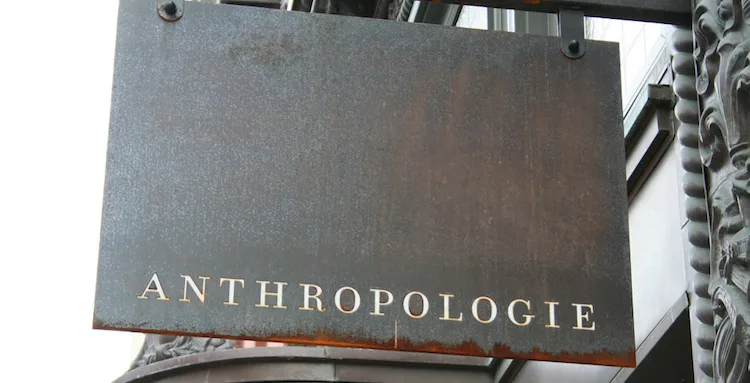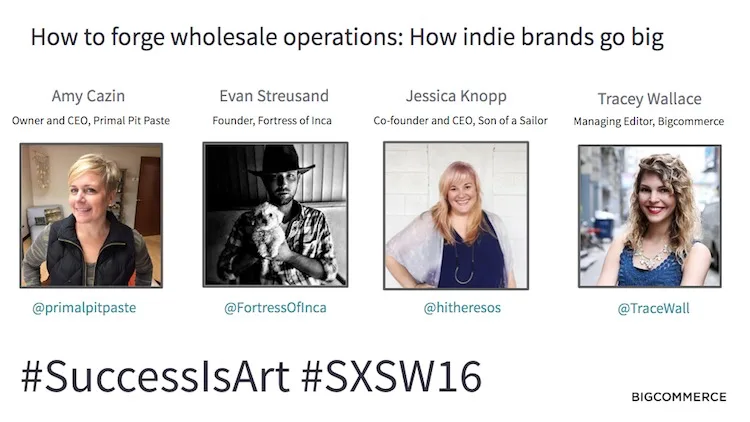How to Forge Wholesale Partnerships: 3 Entrepreneurs Talk Strategy and Success

On Friday, March 11, I hosted a panel at SXSW featuring three Bigcommerce customers with some seriously incredible success stories. Each of these brands function both as B2C and B2B companies and have exploded in growth over the last couple years. Operationalizing wholesale activities was a primary cause for the revenue scale and wholesale b2b software became a priority.
Despite these similarities, each of these brands has a unique story to tell about how it found success through working with leading retailers. Son of a Sailor sells handmade jewelry and other accessories –– and has wholesale partnerships with the likes of Anthropologie and West Elm. Fortress of Inca sources internationally and sustainably for fabrics brought in from Peru to craft shoes –– and has wholesale partnerships with the likes of Free People and the Sundance Catalog. And Primal Pit Paste exists in the health and beauty realm, specifically in the organic and all-natural space –– and has wholesale partnerships with Whole Foods and HEB.
READ MORE: Set It and Forget It Customer Experience Personalization for Scaling Brands
How did these three brands earn their spots in the big brand spotlight? Well, a couple of ways. Attending events was a unanimous must-do for all the brands, a way to get their items in front of prospective bigger brand buyers. But so, too, was having their own independent website –– and using all the customizations possible to pull in organic traffic and properly serve both a B2B and B2C market.
Read through the interviews below to see how each brand forged their relationships, how they manage the process and which came first: revenue or profit.

Let’s start by talking about which big brand stores your products are in and how you forged those relationships?
Evan Streusand, founder of Fortress of Inca: In the last year we have worked with Free People, Anthropologie, the Sundance Catalog and The J. Peterman Catalog. Relationships with these retailers have been built in a number of ways, including trade shows, outreach and then visits to their headquarters. We’ve also been connected through some mutual industry connections.
Relationships with our wholesale and B2B retailers were built through trade shows, outreach & HQ visits.
Jessica Tata, co-founder and CEO of Son of a Sailor: We have been thrilled to work with Anthropologie, Free People, The Conran Shop, West Elm, The Land of Nod and CB2. As we began our business, we encountered a couple of big brand stores that were attending craft shows and scouring Etsy. As we’ve grown, we have gained much more exposure to larger brands through trade shows and networking events. We are also seeing a lot of connectivity through storytelling: some of the stores and websites that have featured our story in a longer-form format have generated some very meaningful relationships.
Sites that featured our story in a longer-form format have generated very meaningful relationships.
Amy Cazin, owner and CEO of Primal Pit Paste: While the majority of our business remains B2C, we have our products in just under 400 small to mid-size stores, as well as Whole Foods regional and global and HEB. We have several other medium and big box stores scheduled to launch this year. Forging relationships with our wholesale customers was an organic growth opportunity. Companies reached out to us through our online presence requesting wholesale pricing. As a result, we hired a wholesale team to support them and engaged brokers this past year.
Forging relationships with our wholesale customers was an organic growth opportunity.
What are some of your biggest challenges in maintaining both a B2C as well as wholesale operations?
Streusand, Fortress of Inca: It’s essentially like running two different businesses, so having the resources to focus on each is difficult at times. Money that we spend to attend wholesale trade shows or to go on sales trips takes away from money that we could spend to develop our online business, and vice versa.
It’s like running 2 businesses. Having the resources to focus on each is difficult at times.
Tata, Son of a Sailor: As Evan mentioned, it is running two separate businesses that require attention in two unique ways. For us, time has always been our most precious resource. As we have navigated the growth of our business, we decided to invest our time heavily in the things that were gaining momentum organically. Our wholesale business blossomed and we focused heavily in maintaining that side of our company and fostering continued sustainable growth. Riding momentum that already existed and keeping it going is much easier than generating activity from nothing. Growing our B2C, specifically online, didn’t happen quite as naturally. So last year we really turned our attention to that part of our business in order to make sure it didn’t get left behind. But it is a struggle to balance the energy that goes into each area of your business, because there are only so many hours in the day!
Our wholesale business blossomed and we focused heavily in maintaining that side of our company.
Cazin, Primal Pit Paste: Our biggest challenge to support B2C and wholesale operations was the short timeline we had to develop a multi-channel process to support infrastructure, understand our cost structures and ensure we had the tools in place to support our brokers and drive profitable sales. It was a significant challenge to slow our on-boarding process during that phase to make sure the individual requirements and nuances of each business were well understood. Buyers who want your product do not want to stand in line to get it. We are very fortunate to be able to have account managers capable of developing strong relationships quickly and that to effectively communicate the value of our implementation timelines.
Buyers who want your product do not want to stand in line to get it.
What are some organizational methods you use to keep everything on track?
Tata, Son of a Sailor: Best question ever! I am an organization enthusiast, so I’m always looking for the best method to keep things in check! We really appreciate online tools that we use in our day-to-day business, like Asana (for task and project management) and Capsule (for contact management) but we also rely on some analog methods, as well. I’m also killer with a label-maker and Ikea and The Container Store are my sanctuaries.
We really appreciate online tools that we use in our day-to-day business, like Asana and Capsule.
Alright, time for a chicken or egg question, which came first: profitable revenue or wholesale partnerships?
Streusand, Fortress of Inca: For us, it was wholesale partnerships. Wholesale increases our volume with our factories, which drives down our production costs. It also drives brand awareness, which leads to an increase in online sales.
Wholesale increases our volume with our factories, which drives down our production costs.
Tata, Son of a Sailor: Our business began sort of accidentally, with a great demand for products that we were making as a hobby. We began with veritably no overhead, and the steady and fast-paced increase in sales grew our business as if we were riding a wave. As we began incurring the costs that come with running a business, we already had the sales driving our decisions. So we were lucky to begin our business seeing profit from the onset. After the first couple of years, our wholesale partnerships became key to continuing to see profit as our expenses continued to grow.
Our wholesale partnerships became key to continuing to see profit as our expenses grew.
Cazin, Primal Pit Paste: Profitable revenue. Our ecommerce business drove our wholesale business. Many of our buyers started with us as customers. Others saw our marketing and PR campaigns and followed bloggers that are rabid fans of our products. They reached out to learn more about us and our product line.
Implementation of a wholesale ecommerce strategy is expensive. Not only are you required to produce more, you are required to hold a larger inventory on a daily basis where forecasting is off from buyers. Without profits to fund the operations, you end up taking on debt, factoring or giving away equity to finance your wholesale channel. Our goal is to continue to own 100% of our company. So, profits have a very big impact on our wholesale strategy.
Implementation of wholesale is expensive. Without profits to fund it, you end up taking on debt.
How does your pricing model work with wholesale? Is there a strategy you’d recommend to maintain margins?
Streusand, Fortress of Inca: We try to at least double our production cost and use that number as our wholesale price. Of course there are exceptions where we feel we either need to cap the wholesale price of a product at a specific amount and sometimes not make double, or other times when we feel we can increase our wholesale price to more than double production costs because we feel the product can be sold for more.
We try to at least double our production cost and use that number as our wholesale price.
Tata, Son of a Sailor: We work with a formula that accounts for raw materials, labor, marketing, packaging and profit, giving us a target number for pricing. We will adjust our actual pricing upwards if the market allows for higher prices, but we try not to ever go below this number. From the very start of Son of a Sailor, it has been very important to us for our products to be attainable –– good design shouldn’t break the bank. Even as some of our items grow in price as we use finer materials and more intricate design, we strive to create a range that doesn’t abandon the customer who wants to spend $20 on a keychain or $40 on a necklace. Now, our greatest challenge is to also support our family of employees, and ourselves, in a way that is sustainable. Austin isn’t getting any cheaper! It’s a delicate dance balancing affordability, quality, expenses and profit in the handmade business.
We work with a formula that accounts for raw materials, labor, marketing, packaging & profit.
Cazin, Primal Pit Paste: The pricing models in wholesale vary significantly. With small to mid-size wholesale customers, the terms are pretty straight forward and the cost models are moderately easy to manage and control. However, signing on with big box is a completely different ball game. Each big box customer has its own processes and requirements – one-offs are expensive to implement, especially when you take on your first few customers. You have to know up front that the end-to-end cost structures are subject to change. The changes eat into your margins. You must know what you are signing up for and account for future requirements.
You have to know up front that the end-to-end cost structures are subject to change.
Are wholesale operation truly profitable or is a brand awareness play?
Streusand, Fortress of Inca: Our wholesale side is definitely profitable and has really been the key to growing our business. It definitely helps with brand awareness as well.
Our wholesale side is definitely profitable and has really been the key to growing our business.
Tata, Son of a Sailor: If you are pricing your items properly, wholesale is truly profitable. There are tools to help streamline the work to preserve that profit margin, like minimum item quantities and order times, properly gauged lead times on production, etc. We’re trying to find and utilize as many of these tools as we can! A wholesale business can not only grow brand awareness (sometimes like wildfire) but it is also a foundation upon which you can build amazing customer relationships with stores that will be a part of the landscape of your business for a long time. Our first wholesale account was with a store called Amelia Presents out of Oxford, Mississippi, and we work with her to this day. We’ve seen a collaboration between our two businesses on the pages of Real Simple magazine, we’ve sold great volumes of product through her store and we have lots of plans for our businesses to grow together in the future. So, while we are focusing increasingly on reaching out to individual customers and further developing our B2C arm, wholesale is a vital and important part of our business.
If you are pricing your items properly, wholesale is truly profitable.
Cazin, Primal Pit Paste: That depends completely on the wholesale customer. There are wholesale customers that you will break even with and wholesale customer who you will lose money on. If you chose to onboard well-known big box brands to get more eyes on your product at a loss, you need to have the costs allocated as part of your marketing budget. This is where it makes sense to rationalize the SKUs you place in big box and drive sales to an ecommerce site for a broader selection of more profitable products.
There are wholesale customers you’ll break even with & wholesale customers you’ll lose money on.
If you have any questions for Amy, Jessica or Evan, leave them in the comments below.
Photo: Flickr, Rachael Voorhees

Tracey is the Director of Marketing at MarketerHire, the marketplace for fast-growth B2B and DTC brands looking for high-quality, pre-vetted freelance marketing talent. She is also the founder of Doris Sleep and was previously the Head of Marketing at Eterneva, both fast-growth DTC brands marketplaces like MarketerHire aim to help. Before that, she was the Global Editor-in-Chief at BigCommerce, where she launched the company’s first online conference (pre-pandemic, nonetheless!), wrote books on How to Sell on Amazon, and worked closely with both ecommerce entrepreneurs and executives at Fortune 1,000 companies to help them scale strategically and profitably. She is a fifth generation Texan, the granddaughter of a depression-era baby turned WWII fighter jet pilot turned self-made millionaire, and wifed up to the truest of heroes, a pediatric trauma nurse, who keeps any of Tracey’s own complaints about business, marketing, or just a seemingly lousy day in perspective.


